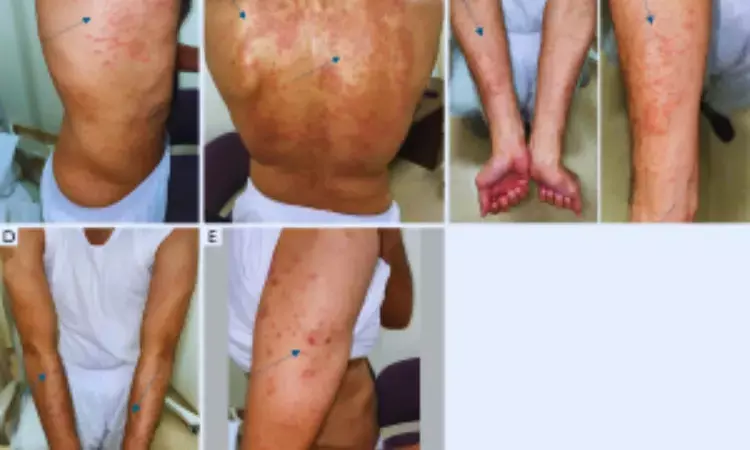- Home
- Medical news & Guidelines
- Anesthesiology
- Cardiology and CTVS
- Critical Care
- Dentistry
- Dermatology
- Diabetes and Endocrinology
- ENT
- Gastroenterology
- Medicine
- Nephrology
- Neurology
- Obstretics-Gynaecology
- Oncology
- Ophthalmology
- Orthopaedics
- Pediatrics-Neonatology
- Psychiatry
- Pulmonology
- Radiology
- Surgery
- Urology
- Laboratory Medicine
- Diet
- Nursing
- Paramedical
- Physiotherapy
- Health news
- Fact Check
- Bone Health Fact Check
- Brain Health Fact Check
- Cancer Related Fact Check
- Child Care Fact Check
- Dental and oral health fact check
- Diabetes and metabolic health fact check
- Diet and Nutrition Fact Check
- Eye and ENT Care Fact Check
- Fitness fact check
- Gut health fact check
- Heart health fact check
- Kidney health fact check
- Medical education fact check
- Men's health fact check
- Respiratory fact check
- Skin and hair care fact check
- Vaccine and Immunization fact check
- Women's health fact check
- AYUSH
- State News
- Andaman and Nicobar Islands
- Andhra Pradesh
- Arunachal Pradesh
- Assam
- Bihar
- Chandigarh
- Chattisgarh
- Dadra and Nagar Haveli
- Daman and Diu
- Delhi
- Goa
- Gujarat
- Haryana
- Himachal Pradesh
- Jammu & Kashmir
- Jharkhand
- Karnataka
- Kerala
- Ladakh
- Lakshadweep
- Madhya Pradesh
- Maharashtra
- Manipur
- Meghalaya
- Mizoram
- Nagaland
- Odisha
- Puducherry
- Punjab
- Rajasthan
- Sikkim
- Tamil Nadu
- Telangana
- Tripura
- Uttar Pradesh
- Uttrakhand
- West Bengal
- Medical Education
- Industry
Maculopapular Eruption After Omalizumab: Case Report Sheds Light on Rare Adverse Event

Saudi Arabia: In a noteworthy case published in AME Case Reports, researchers have documented a rare pityriasis rosea-like skin eruption following the use of omalizumab in a patient with chronic spontaneous urticaria (CSU), drawing attention to an uncommon but important adverse effect associated with the medication.
Omalizumab, a monoclonal antibody often used as a third-line therapy for CSU, has generally shown efficacy in symptom control. However, it has also been associated with a range of side effects, some of which involve the skin. While there have been dermatologic reactions to the drug, such as lichenoid eruptions, urticaria, angioedema, and even dermatomyositis, the occurrence of a maculopapular rash resembling pityriasis rosea (PR) is considered highly unusual.
The case, described by Lamia Alakrash, Department of Dermatology, King Fahd Medical City, Riyadh Second Health Cluster, Riyadh, Saudi Arabia, and colleagues, involved a 46-year-old man with a 14-month history of CSU who had been receiving 300 mg of omalizumab every four weeks. After the eighth dose, he developed a widespread, itchy, red skin eruption beginning six days post-injection. The rash progressed over two weeks, manifesting as discrete and confluent papules, plaques, and erythematous patches over the chest, back, and arms. Notably, the face, scalp, and mucosa were unaffected.
The patient recalled a previous, milder skin reaction after his sixth dose, which had resolved spontaneously and did not prompt medical intervention. There were no recent infections or use of new medications, and standard blood tests, including liver and kidney function, returned normal results.
A skin biopsy was performed, and histopathology revealed findings in line with a PR-like drug eruption, including spongiotic dermatitis and perivascular lymphocytic infiltration with eosinophils. Based on the clinical presentation and pathological features, a drug-induced origin was suspected.
In response, the patient was advised to temporarily discontinue omalizumab and was treated with topical corticosteroids. Follow-up after two weeks showed a marked improvement, with most lesions resolving and only mild post-inflammatory pigmentation remaining. After an 8-week drug holiday, omalizumab was cautiously reintroduced. Encouragingly, the patient tolerated the subsequent doses without further incident.
This case emphasizes the importance of clinician awareness regarding the possibility of rare cutaneous side effects with omalizumab, especially in patients who develop delayed-onset rashes. The recurrence of skin symptoms following repeated exposures also suggests a potential cumulative sensitivity.
The authors advocate for increased vigilance when monitoring patients on omalizumab therapy and highlight the need for further studies to better understand the pathophysiology behind such reactions and to develop clear management protocols.
As omalizumab use expands in dermatology and allergy settings, such case reports contribute significantly to the broader understanding of its safety profile.
Reference:
Alakrash L, Alzamil L, Aljughayman M, Almalki S. Pityriasis rosea-like eruption induced by omalizumab: a case report of a rare side effect. AME Case Rep 2025;9:65.
Dr Kamal Kant Kohli-MBBS, DTCD- a chest specialist with more than 30 years of practice and a flair for writing clinical articles, Dr Kamal Kant Kohli joined Medical Dialogues as a Chief Editor of Medical News. Besides writing articles, as an editor, he proofreads and verifies all the medical content published on Medical Dialogues including those coming from journals, studies,medical conferences,guidelines etc. Email: drkohli@medicaldialogues.in. Contact no. 011-43720751


